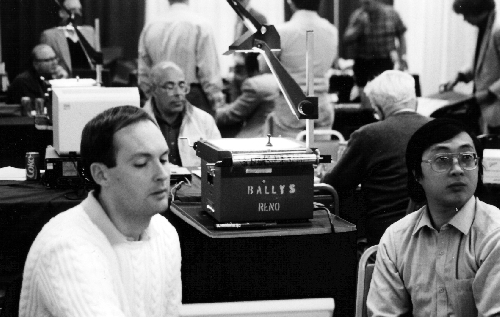Hans Berliner, chess champ and computer scientist, just died.
Nearly two decades before Big Blue weirded out and beat down Garry Kasparov, Berliner conjured the first computer board-game champion, the backgammon whiz Gammanoid. Berliner preferred programming such machines to rely on blunt force rather than logic, a shorter if, perhaps, less revolutionary path. Those same brute methods were utilized in training Watson to become Jeopardy! champion.
Machine consciousness is, of course, the holy grail, but computers don’t need that ability to build or raze cities, to upend social orders or create a fairer system, to bring greater health or be the death of us all. And I’m firmly of the opinion that we don’t get to make sober decisions about the future of machine intelligence at every juncture. Some critical choices will be beyond out control.
Two excerpts: One from Berliner’s NYT obituary by Dylan Loeb McClain; the other from A.I., Jeremy Bernstein’s 1981 New Yorker profile of AI pioneer Marvin Minsky, which begins with a passage about Berliner.
From the New York Times:
In the early 1960s, inspired by the work of programming pioneers in artificial intelligence, Mr. Berliner, who was working at IBM at the time, began writing a program to play chess.
At 40, just after becoming world correspondence champion, Mr. Berliner entered Carnegie Mellon University to pursue a doctorate in computer science. Afterward, he joined the university’s faculty.
As he worked to create a chess computer, he realized that the approach he had previously used, trying to get a computer to use logic, was never going to be as effective as brute force — having the computer analyze as many moves as possible. The problem was that the number of possible moves in a chess game is estimated to be the same as the number of atoms in the universe. How could a computer tackle such a task?
He decided to look for a solution by programming a computer to play what he thought was a simpler game: backgammon. But that was also incredibly complex. There were about 60 possible moves at any one time and 21 possible results from the roll of the dice.
He designed a program that played well up to a point, but invariably something would go wrong. He analyzed the problem and discovered the computer made mistakes when the situation in the game began to change — for example, the computer went from having a clearly better position to one in which the outcome was in doubt — and the program failed to adjust its strategy. He applied fuzzy set theory to allow the program to make estimates of possible outcomes, and that worked.
In July 1979, the newly redesigned program, called BKG 9.8, played and won a match, 7-1, against Luigi Villa, the reigning world backgammon champion. Mr. Berliner’s program thus became the first to defeat a world champion at any board game, though he acknowledged that the program had better dice rolls than Mr. Villa throughout the match.
Mr. Berliner returned to building a chess computer, working with some of his students, including [Carl] Ebeling, who went on to become one of the country’s best-known computer experts, and Murray Campbell, who was later part of the team that designed and built Deep Blue, the computer that beat Garry Kasparov, the reigning champion, in 1997.
From the New Yorker:
In July of 1979, a computer program called BKG 9.8–the creation of Hans Berliner, a professor of computer science at Carnegie-Mellon University, in Pittsburgh–played the winner of the world backgammon championship in Monte Carlo. The program was run on a large computer at Carnegie-Mellon that was connected by satellite to a robot in Monte Carlo. The robot, named Gammonoid, had a visual-display backgammon board on its chest, which exhibited its moves and those of its opponent, Luigi Villa, of Italy, who by beating all his human challengers a short while before had won the right to play against the Gammonoid. The stakes were five thousand dollars, winner take all, and the computer won, seven games to one. It had been expected to lose. In a recent Scientific American article, Berliner wrote:
Not much was expected of the programmed robot…. Although the organizers had made Gammonoid the symbol of the tournament by putting a picture of it on their literature and little robot figures on the trophies, the players knew the existing microprocessors could not give them a good game. Why should the robot be any different?
This view was reinforced at the opening ceremonies in the Summer Sports Palace in Monaco. At one point the overhead lights dimmed, the orchestra began playing the theme of the film Star Wars, and a spotlight focused on an opening in the stage curtain through which Gammonoid was supposed to propel itself onto the stage. To my dismay the robot got entangled and its appearance was delayed for five minutes.
This was one of the few mistakes the robot made. Backgammon is now the first board or card game with, in effect, a machine world champion. Checkers, chess, go, and the rest will follow–and quite possibly soon. But what does that mean for us, for our sense of uniqueness and worth–especially as machines evolve whose output we can less distinguish from our own?•


